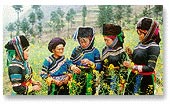Home » Ethnic People » Co Lao
The Co Lao People

The Co Lao have a population of about 1,500, living in Dong Van and Hoang Su Phi districts (Ha Giang province). They are sometimes called the Ke Lao. The Co Lao language belongs to the Kadai group.
In Dong Van, the Co Lao cultivate terraced fields and grow maize in mountain hollows. In Hoang Su Phi they grow rice in submerged fields or hilly soil. Basketry and woodwork are popular handicrafts, they produce bamboo mats, lattices, large winnowing baskets, panniers, tables, chairs and horse saddles.
Co Lao males wear trousers like many other peoples in the northern border area. Co Lao women wear trousers and a five-panel dress reaching below the knees, buttoning under the left armpit, and decorated with bands of cloth of different colours attached to the chest.
Each village has about 15-20 households. Their houses are built level with the ground, commonly with three bays and two lean-tos. Each house is a inhabited by small family comprising parents and children; married sons rarely live with their parents.
Each Co Lao group has a definite number of family lineages. The patrilineal pattern is adopted. Co Lao women observe strict abstinence to facilitate delivery and have healthy babies. In Dong Van, people incinerate the placentas of new-born babies then put them into rock holes in the forest so that they are not trampled upon by [dantoc3.jpg] dogs or pigs. After three days and nights for sons and 2 days and 3 nights for daughters, the babies are baptized by their parents. The first child receives the name given by its maternal grandmother. The dead person is buried with a fasting rite. At burial, rocks are placed in circles around the tomb. Each circle corresponds to 10 years of age of the deceased. The rock circles are then covered with earth.
Ancestors of 3-4 generations are allowed to be worshipped at home. The spirit of the earth is venerated by each family and the whole village. The spirit of the terraced fields is represented by an unusual stone placed in the highest rock hole. Ceremonies and festivals are held on the 3rd of the 3rd lunar month, the 5th of the 5th month, the 15th of the 7th month and the 9th of the 9th month. The New Year Festival is the biggest.

